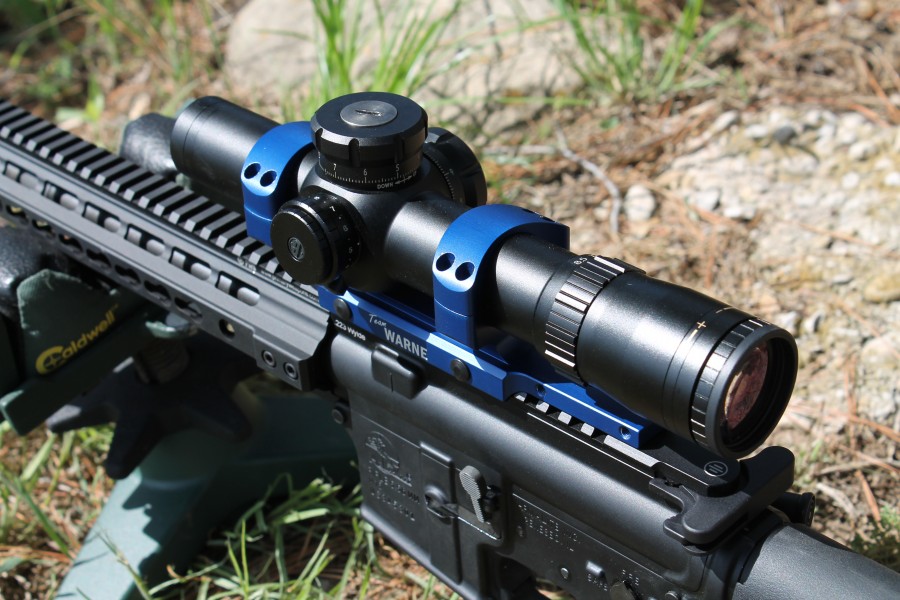
Spend enough time reading about optics on the internet and you might get the feeling that the perfect optic scales from a true 1X up to  X, weighs less than a feather, and can give you a clear, crisp picture in the dark. It should also cost less than $100, be able to withstand a free fall from space, and have a reticle that reads the wind. Okay, that last part might be a bit much, but I don’t think I’m far off the mark. In the world of running and gunning — 2-gunning, 3-gunning, or otherwise — there are always sacrifices to be made. Sometimes, quality means added weight. Other times, shedding ounces means shedding features. The SMRS from Bushnell certainly provides amazing optical clarity and the ability to jump from a nearly perfect 1X to 8.5X. But it does all that by sacrificing light weight on the altar of compromise . . .
X, weighs less than a feather, and can give you a clear, crisp picture in the dark. It should also cost less than $100, be able to withstand a free fall from space, and have a reticle that reads the wind. Okay, that last part might be a bit much, but I don’t think I’m far off the mark. In the world of running and gunning — 2-gunning, 3-gunning, or otherwise — there are always sacrifices to be made. Sometimes, quality means added weight. Other times, shedding ounces means shedding features. The SMRS from Bushnell certainly provides amazing optical clarity and the ability to jump from a nearly perfect 1X to 8.5X. But it does all that by sacrificing light weight on the altar of compromise . . .
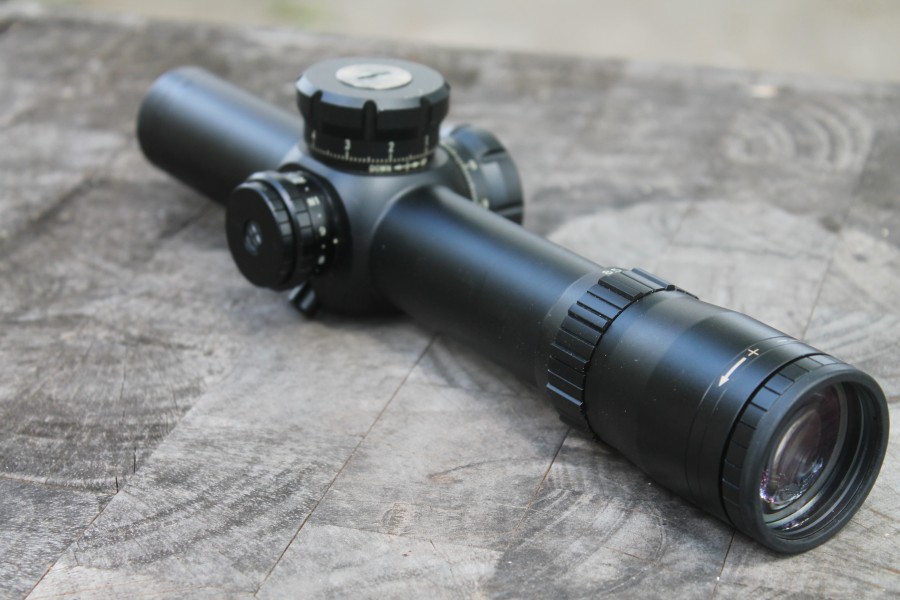
The Bushnell SMRS is a first focal plane 1-8.5X scope wrapped in a 34mm tube with an illuminated reticle. It features 1/10 mil lockable turrets, an illumination selection that goes to 11, and fine-focus capabilities. All of these are features that I’d expect from a scope in this price range (~$2000 street price). In my testing, I was unable to break the scope using it on a variety of 5.56 and .300 BLK uppers. All of the controls are crisp, provide excellent tactile feedback, and I never got it to lose zero on any of the rifles with which I tested it.
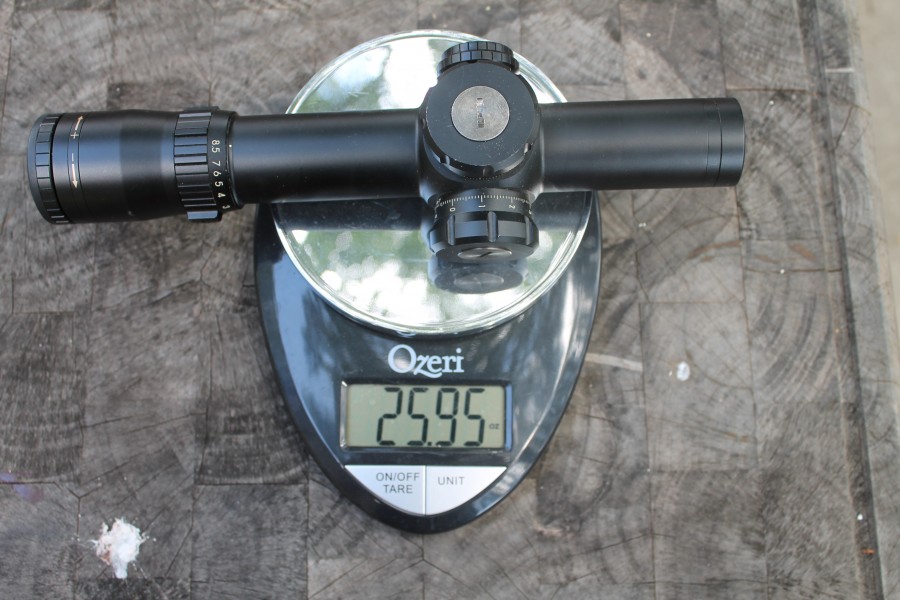
The SMRS boasts some of the best glass I’ve ever used, a point I’ll beat to death in the next few paragraphs, but not before I mention how goshdarn heavy it is. Bushnell claims 23 oz (1.44 lbs.) which sure feels like a lot. Until you put it on your scale and it measures 25.95 oz (1.62 lbs.). Holy moly it’s heavy. Enough so that on a lightweight AR 15, it makes the whole rig a little top-heavy.
Bushnell doesn’t mention it anywhere on their site, but I think this scope is firmly geared towards those shooting the heavy class guns chambered primarily in .308. Slapped atop a SIG 716 or any of the AR-10 platform rifles, I think the extra weight would sort of blend in with the rest of the whole “running a heavy gun” thing.
I don’t know a ton about how to make a rifle scope, but everything I’ve read says that a variable power scope with a true 1X setting is nearly impossible to produce. No matter what you do, there’s always going to be a touch of distortion at the lowest setting. The SMRS is not immune to this, and even though it has a very good low power field of view, it is still a bit disorienting to shoot with both eyes open as there’s a slightly higher magnification coming through to the dominant eye. That said, it is one of the finest “nearly 1X” scopes I’ve ever tested. While I continue to belabor the quality of the glass, let’s turn our attention to the reticle and general view provided the shooter.
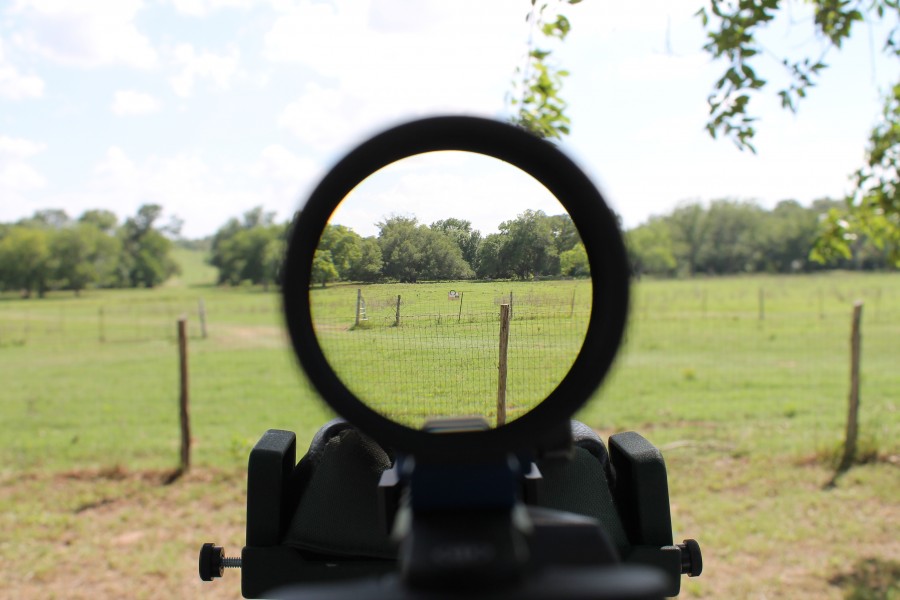
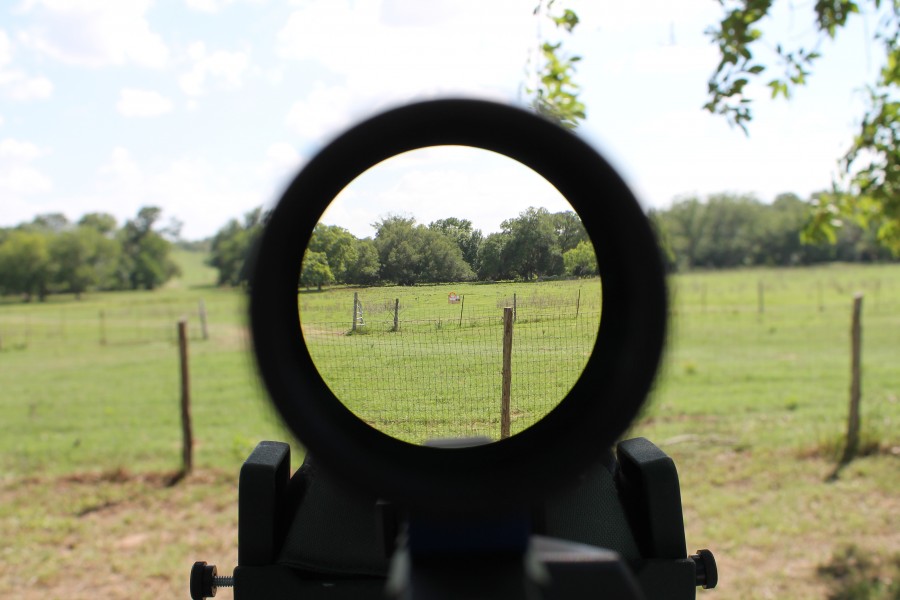
At the 1X setting, the reticle is all but invisible and you are presented with a very clean piece of glass. I found it easiest in bright daylight to crank up the illumination to 11 to get a good view of the circular reticle. In the pictures above, the top picture does not have the reticle illuminated. The bottom pic shows it at the highest setting. The closest fence posts you see are at about 15 yards, the further are at ~60 yards, and the reticle is actually resting on a target at 100 yards.
At close range, this uncluttered view provides a very good, albeit small aiming point perfect for close up work. As you can also see, there is no noticeable darkness, hazing, or blurring. The glass is absolutely spectacular in this regard.
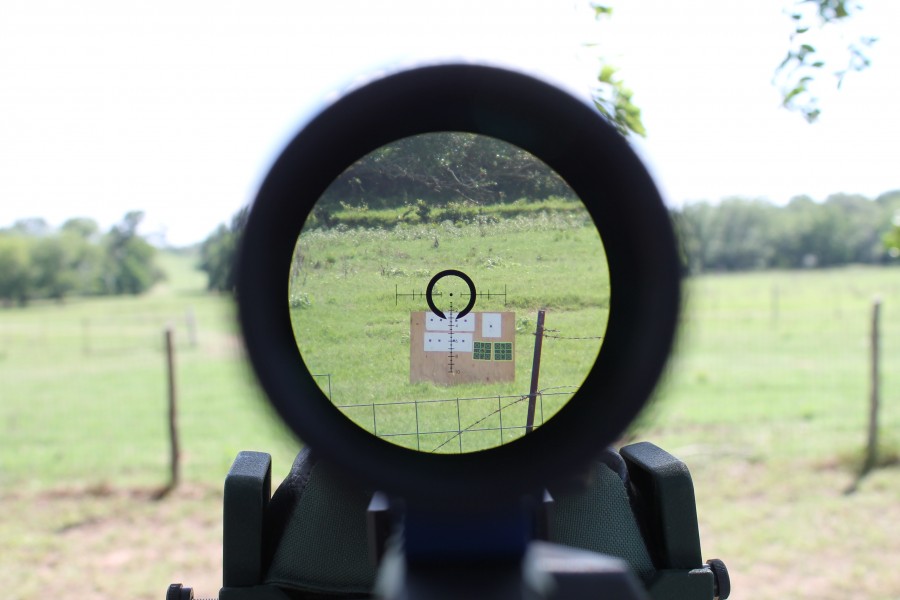
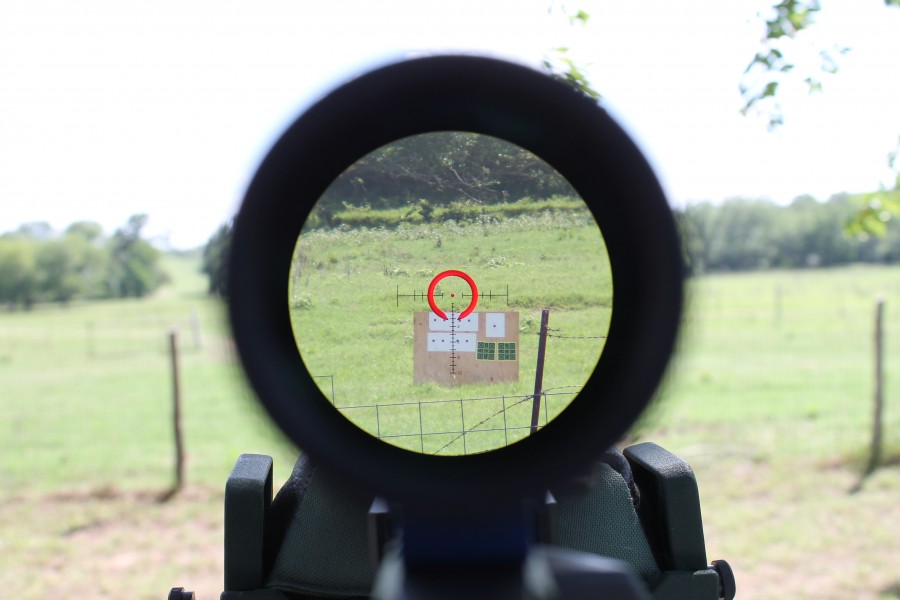
Cranked up to 8.5 X, you can see the full reticle develop. Again, the glass is very clear, and free of any sort of distortion. Full illumination at night has very little to no bleed out near the reticle. Seeing such bleed is a surefire way to spot a cheap scope, but the SMRS has no evidence of this. I had no problem using this scope at the highest power in low light, though it does not collect as much light as a scope with say a 50 mm objective. It is still very good, a factor that should be assumed when the customer is looking at paying nearly $2000. Below is a screenshot from Bushnell’s manual on the SMRS that shows the BTR-2 reticle in a bit more detail.
The Bushnell manual is a bit vague on the actual subtensions used in this reticle other than to give an overview of what each vertical hash mark on the horizontal line equates to using a 10 inch target at various distances measured in meters. I’d MUCH prefer a better explanation of how this reticle is set up and using the same system (metric or freedom units) would also be greatly appreciated if Bushnell is doing it. I finally broke down and measured off 100 yards exactly, and set up a piece of cardboard with a crosshair and hash marks every 3.6 inches (1 mil @ 100 yards). What I found was that the vertical line fits EXACTLY as advertised. Each number corresponds to the number of mils in elevation if you prefer to hold for elevation. However, the horizontal markings don’t seem to line up at all with a mil based system. When I moved the reticle over to a brightly painted 10″ x 10″ steel plate at the aforementioned 100 yards, it fit neatly between the white space on either side of aiming dot leading me to believe that the horizontal axis is graduated in MOA.

I’m barely a fan of having MOA graduated reticles and mil turrets, so having the two systems mixed in the reticle was far too much for my lizard brain. I question the decision to use a mixed reticle when the turrets and vertical crosshair is graduated in mils, but I’m not on the design team for Bushnell. About those turrets though…
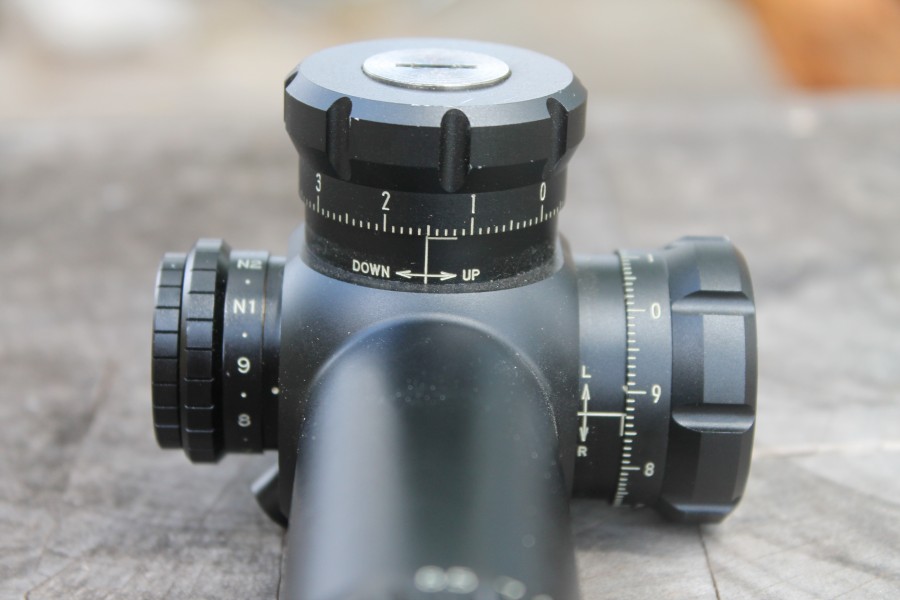
There’s this constant battle that rages in my head about capped or uncapped turrets. In a high quality scope that tracks well, the ability to quickly dial elevation and wind (if it is steady) means much more precision in your aiming. The downside to having uncapped turrets has one stark example from last year’s hunting season. I watched Nick miss a deer because he’d bumped his windage turret walking around and the gun shot about five inches from point of aim because of it. Bushnell seems to have found a worthy compromise in the SMRS by using uncapped turrets that pop up for adjustment and are smashed back down to lock them in place. It takes a fair amount of force to pull the turret cap up, but once up, the adjustments are very crisp. Shooting in the unlocked or locked position seemed to not make a difference whatsoever in point of impact.
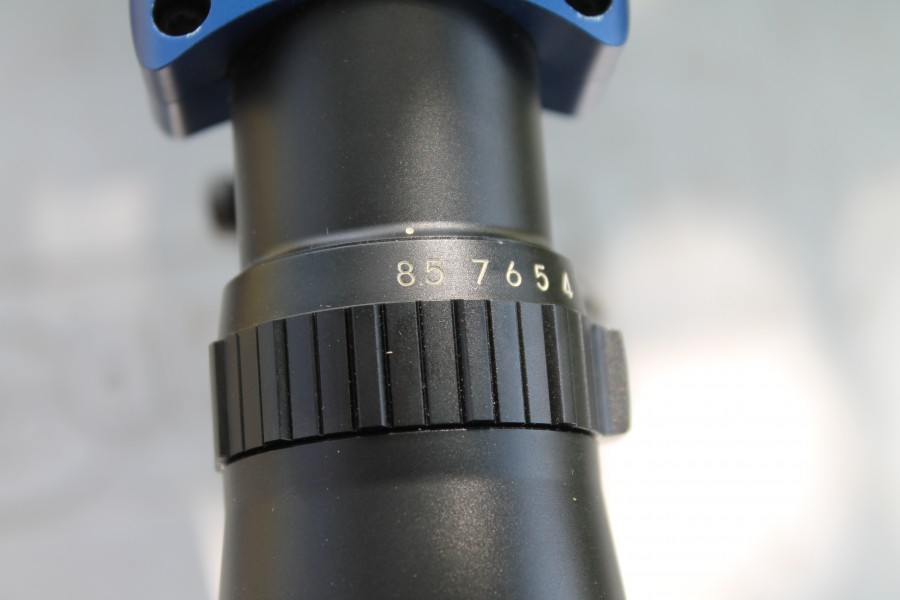
A tracking test showed that the measurements on the scope are repeatable and calibrated to accepted measurements. Dial this scope up 5 mils, and your shot will impact 5 mils high. Screw it back down 5 mils and your shot will be back to your original zero. If you unscrew the slotted screw on top, you can remove the turret, and reset it to a zero mark so that you have a handy reference point. Again, this is helpful stuff for those looking to stretch the legs of their battle rifle a bit, something that crisp 8X glass definitely allows for.
Specifications: Bushnell SMRS 1-8.5x 24mm
- Finish:Matte
- Power/Obj Lens:1-8.5x 24mm
- Reticle:Illuminated BTR-2
- Lens Coating:Fully Multi-Coated & Ultra Wide Band Coating
- Tube Diameter:34mm
- Field of View: ft @ 100 yds
- 105 @ 1x
- [email protected]
- Field of View: m @ 100 m
- 32@1x
- [email protected]
- Advertised Weight: 23 oz
- Measured Weight: 25.95 oz
- Length: in/mm – 10.2/265
- Eye Relief: in/mm – 3.5/8.9
- Exit Pupil: mm
- 13.2 @ 1x
- 3.2 @ 8.5x
- Click Value:
- .34 in.@100 yds
- 10 mm@100 m
- Adj Range:
- 60 in.@100 yds
- 1.5 m@100 m
- Mounting Length: in/mm – 7.4/188
- Focal Plane: First
- Price: $1781.75 @ Amazon
*A note on fitment and ring selection. I found that due to the shape of the SMRS, I was unable to utilize a Leupold Mark 8 IMS Mount and instead ended up using the Warne R.A.M.P mount for the duration of my testing. If you elect to use the SMRS, I’d recommend that mount as it works very well for this application.
Ratings (out of five stars):
Fit, Finish, Build Quality * * * * *
As you’d expect from a ~$2000 optic from a reputable company like Bushnell, the overall fit and finish is impeccable. The controls are crisp, well-marked, and functional. There are no defects in the finish of the scope body, likewise in the glass. Changes using the turrets reward the user with solid clicks. Additionally, the heft adds to the feeling of overall quality.
Optical Quality * * * * *
This is really good glass. No matter whether you have it on 1X or 8.5X, you’ll be rewarded with a crisp view of the world. This is especially evident in lower light situations where the the larger 34 mm body and subsequently larger diameter glass allows more light in vs. a smaller scope. Again, the penalty is weight, but if supreme optical quality is your bag, the SMRS does not disappoint.
Reticle * * *
I have two major gripes with the Bushnell reticle. The first is that unless it is illuminated, it’s impossible to pick up at 1X. I was unable to exhaust the battery on the SMRS, but having the illumination cranked to 11 to pick up the reticle on the lowest power setting sort of defeats the purpose of even having a 1X setting. The second gripe is that the vertical crosshair is marked in mils while the horizontal appears to be graduated in MOA. I’m sure there’s a reason for this, but it isn’t immediately apparent to me. I would have preferred that Bushnell had used the same system of measurement throughout.
Overall Rating * * * *
The SMRS is above a 3-star rating for sure, but it just squeaks into 4-star territory by a hair. I don’t think there’s anything fundamentally wrong with it as it is a very good scope provided you don’t mind the weight or the reticle which I believe are the two weak points of this scope. The weight is unavoidable in my mind. A large objective 1X – 8.5X scope just has to be hefty to accommodate all those big lenses. But the reticle is the glaring mark against the SMRS. It doesn’t use the same measurement system for graduation and it is impossible to pick up at 1X. Fix the reticle and this is a standout optic. Otherwise, it’s a good scope with really crisp optics and controls that befit the ~$2000 price tag.

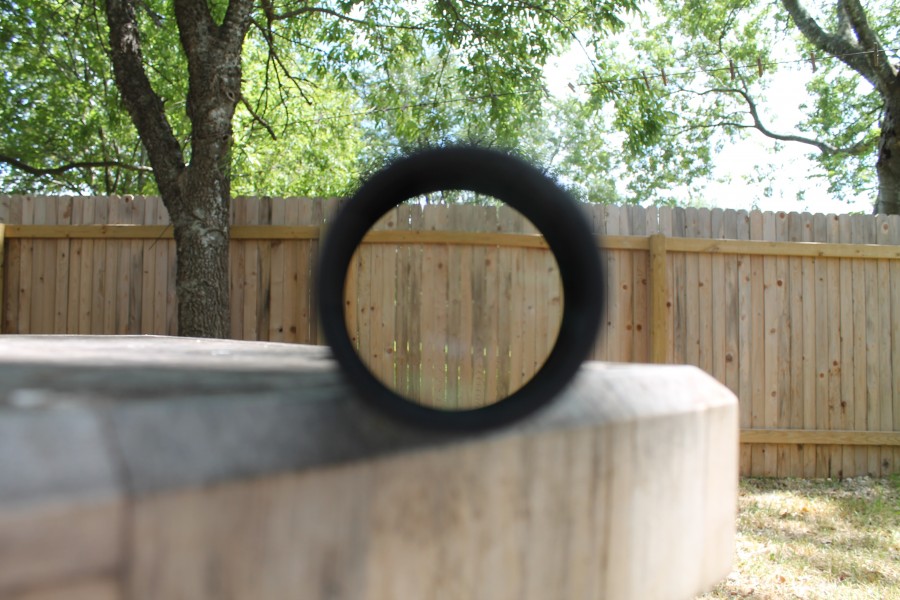
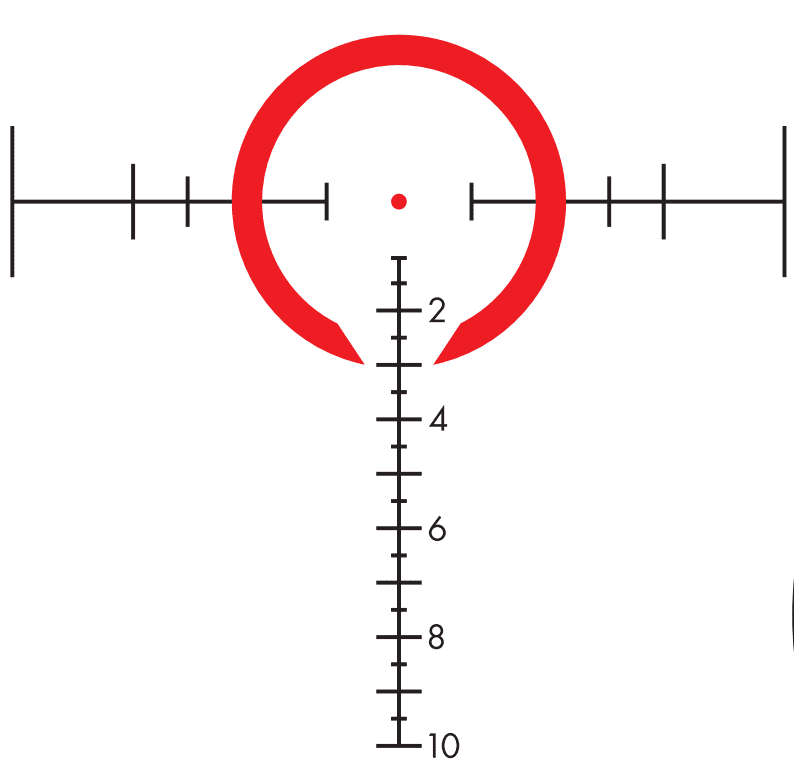




Lol. I thought that said $178 at Amazon, then did a double take. 😉
The post made me chuckle. Initially, I thought it said $178 on Amazon, but I had to double-check.
Interesting scope, but if I was going to spend $2000 on a scope it would be mil/mil and lighter weight. That reticle is waaay to small at the lower powers, what is the point of a magnified optic if you can’t see the reticle? Might as well put a nice spotting scope on the rifle.
It might just be the photos, but a FFP scope with a high magnification range will always shrink the reticle at low magnification. You can’t cheat physics.
Scope manufacturers are going to have to start making dual focal plane scopes, FFP with a BDC or Mil Reticle, and SFP with a holo dot. I think that there may even be a 1-6 scope that already does this.
Just did a little looking, it looks like US Optics is doing this already, 4MOA red dot in SFP, reticle in FFP. This is in their RED DOT or (c) designated scopes. Same price point as this scope as well.
Schmidt and bender, premier, and a couple other high end makers are doing this as well.
I mean that’s basically what this scope is doing right? Has the illuminated ring around the center of the crosshairs with a dot in the middle and the ring basically shrinks to the point of being a red dot on the lowest magnification setting. Which is exactly what you would want in a close in eyes open scenario.
To the original comment, I assume if you are far enough away from something that you need the rest of the reticle for ranging or whatever, then hopefully you are not still trying to use the 1x setting. That’s why I don’t bother paying for FFP. If I need the reticle for ranging I am probably on max power for my scope.
As a recent Bushnell ERS 3.5-21 w/ zero stop owner, your review sounds spot on. The 34mm scope is indeed built like a tank – I think mine is 35 ounces. I like the Leupold Mark 6 w/ 3-18x better, but couldn’t justify the extra cost. My reticle is mil/mil all around. I don’t see any point in mixing the two. One could get reasonably fast with MOA / mil conversion but it just seems unnecessary.
Given you seem to be using this on ARs, I’d recommend the La Rue LT-111 or similar QD mount. It lets you enjoy your sweet optics on multiple platforms. I’m not sure if the excellent Warne mounts have a QD option. Mine will be doing duty on ARs from 5.56 to 300 BLK and will also mount to my Savage 110 BA on a Ken Ferrell 20 MOA rail.
I much prefer a second focal plane reticle for a sight I’m going to use a bit at the lowest magnifications, especially for 3-gun and the like. Sight it in at highest magnification for the longer precision shots. For the closer shots at low to no magnification, the reticle size is still the same so you can still see the darn thing and it acts like a red-dot sight. There may be a minute shift in point of aim, point of impact close-up but at those distances it doesn’t really matter. But that’s just me. (and some other 3-gunners who use Swarovski/Kahles/Vortex 1-4/6/8 sights)
I always wondered. The “horseshoe” reticle seems to be gaining popularity, and I read that it has something to do with the .300 AAC BLK. Can somebody tell me a little more about this reticle and the advantages/disadvantages?
I think it more or less has to do with low power illuminated adjustable first focal plane scopes in general. It allows a generous “Red Dot” at low magnification, and then the bottom of the horseshoe is out of the way for a balistic/MOA/MIL drop reticle at the high powers. The Horseshoe or 3/4 circle is also very good as a “Center of Mass” aiming system. Rather than trying to float a tiny dot onto a precise point, just get the circle over center mass, the circle usually covering about 12″-18″ across, and take your shot, a little less precise, but fast.
Uhm yeah, would you stop reviewing scopes that cost more than a used car? I’m sure 80% of the readers will not spend that kind of money on a scope. Sure it’s nice to see what’s new and hip but still A $300 scope would do just a good a job as that one. And be more useful to the majority of people that can afford it.
I don’t think you’re entirely correct. Sure, there are plenty of budget shooters, but just about anyone who gets into competition shooting, especially 3-gun who these scopes are targeted towards, is going to have money to spend. The cost of one of these scopes is roughly the cost of a mid-high end AR that someone will buy for competition. So, instead of buying another gun, buy the awesome scope to put on another one.
Unless you don’t have money to spend and you want to get into 3 gun. So what you are trying to say is… 3 gun is only for those who’s budget includes a $2000 scope?
“A $300 scope would do just a good a job as that one” No, it won’t. You may be able to get by with a $300 scope, but it’s not going to be the same as one that’s nearly $2k.
In my experience the quality difference between a 35$ scope and $300 to $500 scope is night and day. I’d give the $35 dollar scope a 1 or 2 out of 10. I’d give the 300 to 500 dollar scope a 8 or 9 out of 10. And – the $2000 – $3000 dollar scope i’d give a 10/10. So that last small percentage between having a great scope and having the very best costs all the difference. The price vs quality graph is logarithmic. To me, it’s a matter of what is “good enough.”
I would say the sacrifice for the scope in question is not weight – but price and weight.
A $35 scope is shit. You just wasted $35. I have both lower end Bushnell scopes ($200-300) and high end Nightforce scopes ($1600 and up). I can definitely tell the difference.
“To me, it’s a matter of what is “good enough.”” Yes, personal opinion will be a factor. But trying to say “A $300 scope is just as good as a $2000 scope” is just plain wrong. I don’t think everyone needs to buy a $2000 scope. There are cheaper scopes that will do the job capably, if not as well as the expensive ones, but pretending like a high end scope not worth it just because you don’t want to pay that kind of money is sour grapes.
Exactly right.
The jump in quality from a sub-$100 scope to the $800 range is a huge improvement. Night and day, black and white levels of difference.
The increase in quality in a scope or binoculars from $800 to $3000 is a very much smaller increment.
The vast majority of scope buyers aren’t educated enough about optics to even know where to look for the differences between a $800 and $3000 scope.
No, nobody’s going to “stop reviewing expensive scopes.” It’s like back when I read dead-tree car magazines, and schlubs would write in saying, “Stop writing about Lamborghinis and Ferraris and write about cars we can afford!” Well, in that case, the answer was simple: Lamborghinis and Ferraris are interesting, and Monte Carlos and Tauruses don’t sell magazines. Here, the answer is both the same and different. Good scopes are interesting, and there’s a market for them. Quit being a whiner. Plenty of lower cost scopes have been reviewed here. For example, type “primary arms” into the search box to the right and look for the reviews there. One of them is the Primary Arms 4-14×44 Mil Dot FFP scope under $300. There’s another for under $100, though at that point you really get what you pay for.
$1800? Baw haw haw haw. NFW!
The mfg that brings out a line or GREAT scopes a reasonable price should have a great future. Say $500 for similar to this unit aimed at the AR10.
My mfg experience is in injection molding and machining/welding not optics but I can’t see where you end up at TWO THOUSAND DOLLARS for a scope. At such made from unicorn horn, with unobtainium lens, and lens coated with spermwhale oil distillates? I dt see the price on a cost + basis.
Or is pricing set using the Tiffany lamp model (as much as can extract from the rubes).
I have one of these
http://www.thetruthaboutguns.com/2013/02/foghorn/gear-review-leupold-mark-ar-mod-1-1-5-4x20mm-spr/
and it is a far nicer piece of equipment than I am a shooter. Everyone who shoots my AR loves it. It doesn’t go as high but there are very similar 1-6x scopes in the same class.
Quality optical glass costs money. Coatings cost money. Grinding optical lenses cost money, as do the machines necessary to check the uniformity of the shape of a piece of ground glass.
Good review! Now that the weight seems to be coming down on .308 semi-autos, I’m considering acquiring one for hunting and home defense. This scope would work for both applications.
The concept of a 1-Something is to combine a red dot and a magnifying scope into a single package. Of course, reticle parallax, finite exit pupil, and finite eye relief means a 1-Something will never be as flexible as a red dot at 1X. However, if the eyebox is generous enough and the dot is bright enough, it gets pretty damn close. Good examples are S&B short dot, Swarovski, and Vortex Razor.
When the reticle is as dim as it is on the SMRS, what is the point of the 1X setting? I understand it’s useful in low light, but low light is only a small fraction of the day.
I’ll take things on which i could never, ever justify that level of spending for $2149, Alex.
The manual clearly states what the horizontal subtensions are for – not MOA but 10″ at various distances; 100M, 200M etc up to 800M.
I have the 1-6.5x version on my 300BLK and absolutely love it. I’d highly recommend the SFP version as the horseshoe is very useful at 1X (think EoTech) and any ranging using the mil scale is going to be at max zoom. SFP also has better illumination, I rarely go above setting 6 in direct sunlight.
FFP is great for precision shooting, I have a 4-16 and 5-25 that are both mil/mil and FFP, but SFP is the way to go for an illuminated short zoom.
The manual makes reference to the vertical lines on the horizontal crosshair corresponding to known 10″ sizes at various distances (measured in meters). There’s nothing in the manual describing the distance between the vertical hashes on the horizontal crosshair.
Agreed, I also would like to know what the horizontal spacing is. Or have wind drift points like the Trijicon horseshoe dot… I just meant there is not a mix of MOA/MIL on the reticle. More like a mix of MIL/something Bushnell made up.
I will say that I tried several 1-xxx sights before getting the 1-6.5 including the 1-8.5 smrs FFP, and that reticle was the best fit for 300BLK. You can zero supers at the center point and use the mil scale to drop subs, or as I have recently found zero 220Gr subs at 50Y on the center point and 125Gr supers will be at the top of the horseshoe at 100Y. Works great.
While you’re right, you overlooked Jeremy’s point. He doesn’t just want to know what the “10 inch” markings are, he wants to know the graduations in between, and everything else. The $100 BSA scope on my 10/22 has a two page manual that tells me every single subtension, from the spaces between the marks all the way down to the .25 mil thickness of the lines themselves. The point is, if my hundred-buck scope manufacturer provides all that info, then the maker of a $2k scope really should, too.
I opted for the Primary arms 1-6 gen II for $269. This scope looks really nice, but I wouldn’t spend this much on a scope unless I won the lottery.
Just ordered one of those the other day as well. I’m interested to see how nice the glass is. I’ve been very happy with my PA Microdots.
I get the impression that a lot of commenters here have never actually looked through a high-end scope.
Y’all probably think your phone takes good photographs, too…
I wonder if the illumination is like my sorry *ss Leupold Mark 6 1-6x scope where you shift by 1-3 degrees and can no longer see the illuminated reticle! Boy that really chaps me. Leupold says it is by design. GRRRR.
I jsut called bushnell and asked about the horizontal subtension lines. He stated that it is not in MOA and it is MIL.
i asked how can it be since there isn’t many hash marks. He didn’t have a reply other than it is a MIL/ MIL turret.
I wanted to draft you this little bit of note to finally give many thanks yet again for your pleasant suggestions you have featured on this site. This has been really surprisingly generous of people like you to give unhampered all that a number of people could have offered for an ebook in making some profit on their own, especially seeing that you could possibly have done it in case you wanted. These good tips as well acted to provide a great way to be sure that some people have the same passion like my very own to see good deal more around this condition. I’m sure there are several more enjoyable instances in the future for individuals that examine your blog.
ラブドール 通販 等身大のダッチワイフはあなたの性生活にたくさんの楽しみを加えることができます
Primary arms 1-6 gen II cost $269. This scope is beautiful, but I wouldn’t buy it unless I won the lotto.
SMRS adhd doctors near me
is a first focal plane 1-8.5X scope wrapped in a 34mm tube with an illuminated reticle. It features 1/10 mil lockable
hotel di sleman yogyakarta adalah sebuah bangunan atau sekumpulan bangunan yang dirancang untuk menyediakan akomodasi bagi orang-orang yang sedang bepergian atau yang sedang berlibur. Hotel biasanya menyediakan fasilitas seperti kamar tidur, makan, dan tempat bersantai.Sementara itu, vila adalah sebuah bangunan atau sekumpulan bangunan yang biasanya terletak di daerah pedesaan atau di tepi pantai, yang dirancang untuk digunakan sebagai tempat tinggal atau kediaman bagi orang-orang yang ingin menghabiskan waktu libur mereka di tempat yang tenang dan asri. Vila biasanya lebih besar dan lebih mewah daripada hotel, dan seringkali dilengkapi dengan fasilitas seperti kolam renang, taman, dan lain-lain.
If you’re looking to get fit and stay motivated, look no further than our fitness products! We’ve got all the gear you need to start your journey.
I dont have any experience with any of them but if they are close in price I would go with the USO as it would probably have better resale value trap the cat. I am sure their is others that can chime in with more experience with one or both but personally I would go with the USO as I was looking at getting one and still might in the future.
I chose the Primary limbs 1–6 generation II for $269. Even if I won the lottery, I wouldn’t spend this much money on a scope.
anak patung dewasa https://ms.realsexdoll.com
The depth of information and the way you’ve structured the content make it a valuable resource for anyone seeking knowledge in this area.
fnf mods is a fascinating website devoted to Friday Night Funkin’ game series. In this series of games, players are challenged with loads of wonderful music, rhythms and sounds that keep players engaged without getting bored.
I’ve been troubled for several days with this topic. I bookmark this site and will find your posts frequently in the future. python course with placement in coimbatore
For adventure riders who push their bikes to the limits on rugged terrains, the importance of a Himalayan 450 radiator guard cannot be overstated. This essential accessory is designed specifically to protect the radiator of your Himalayan 450, a critical component in managing the engine’s temperature, from the inevitable debris and rocks kicked up during off-road expeditions. Not only does the radiator guard ensure that your adventures aren’t cut short by overheating issues, but it also adds an extra layer of rugged aesthetics to your bike. Crafted with durability in mind, a quality Himalayan 450 radiator guard is an investment in both the longevity and performance of your motorcycle, ensuring that it remains your reliable partner on every trail you choose to conquer.
Comments are closed.